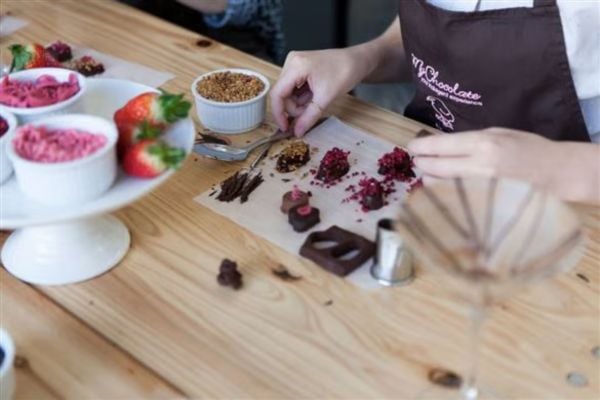The Delicious History Of Chocolate: From Ritual To Treat
07 July 2025

There are few things in life as universally loved as chocolate. Whether you like it dark and intense, milky and mellow, or white and wildly sweet, it's safe to say that chocolate has conquered hearts (and taste buds) across the globe.
But where did it all begin? How did a humble bean transform into the glorious bars and ganache we devour today?
As we celebrate World Chocolate Day on 7th July, it seems only fair to give chocolate its historical due. So, pull up a chair, grab a square (or seven) of your favourite bar, and let's unwrap the delicious story of chocolate through the ages.
Ancient Beginnings: Mayans, Magic and Molé
Long before Cadbury and corner shops, chocolate was considered a divine gift. The Mayans, who were thriving in Central America over 2,000 years ago, were among the first to cultivate cacao trees. To them, cacao was more than just a treat - it was sacred.
They didn't eat it in the form of sweet little truffles, though. Instead, cacao beans were ground into a bitter paste and mixed with water, chilli and spices to create a ceremonial drink. This early version of hot chocolate was apparently energising, slightly spicy, and - let's be honest - probably not quite what you'd want with your biscuit.
Still, it was so revered that the Mayans used cacao in rituals, celebrations and even as currency. Imagine popping into a shop and handing over a handful of cocoa beans for a loaf of bread. Better hope you didn't snack on your savings.
Aztecs Take It Up a Notch
When the Aztecs rose to power in the 14th century, they adopted the cacao bean with gusto. Like the Mayans, they believed it had divine origins - gifted by the gods, no less.
The Aztec emperor Montezuma II was rumoured to drink litres of this cacao concoction daily, convinced it was an aphrodisiac and a strength booster.
Cacao remained so valuable that it was used for trade and as payment for taxes. If someone robbed your wallet back then, they'd essentially be stealing your chocolate stash. Truly a crime of passion.
The Sweet Shift in Europe
Everything changed when Spanish conquistadors brought cacao back to Europe in the 16th century. Naturally, the Europeans took one sip of the bitter, spiced brew and went, "Absolutely not." So they did what we always do - they added sugar.
Sweetened chocolate caught on like wildfire. It became a luxurious drink for the aristocracy, enjoyed in high society parlours and even at the court of Louis XIV. Chocolate houses began to spring up across London, where people gathered not just to drink chocolate, but to gossip, play cards, and engage in what we'll generously call "spirited discussion".
Eventually, thanks to the Industrial Revolution and some very clever (and probably very sticky) hands, chocolate made the leap from a drink to a solid. By the 19th century, people were snacking on chocolate bars rather than sipping posh cocoa with pinkies raised.
Chocolate for the Masses
The mid-1800s were a big moment for chocolate. In 1847, British company Fry and Sons created the first modern chocolate bar using a moulded paste of sugar, cocoa butter and chocolate liquor. It wasn't smooth like we know today, but it was a start.
From there, chocolate became more affordable and accessible, thanks to mass production and relentless public demand. Companies like Cadbury, Nestlé and Lindt began crafting smoother, creamier versions and invented new forms - chocolate boxes, truffles, pralines. Yes, this is the part of history we're all very thankful for.
By the early 20th century, chocolate was no longer reserved for royalty and the ridiculously wealthy. It had become a treat for all, whether you were a child saving pocket money or a tired adult surviving a Tuesday.
Modern Morsels and Ethical Questions
Fast forward to today, and chocolate is everywhere - from supermarket shelves to five-star kitchens. We've got every variation under the sun: dairy-free, raw, ruby, infused with lavender, chilli or popping candy. There's something for everyone (even people who like white chocolate, for reasons unknown).
But with popularity comes responsibility. Modern chocolate production has sparked important conversations around fair trade, sustainability and ethical sourcing. Some big-name brands are working to improve conditions for cacao farmers, reduce child labour, and grow cacao more sustainably. It's a work in progress, but one we should all keep an eye on.
Next time you pick up a bar, a bag of coffee, or even some bananas, have a look at the label. Supporting ethical products/chocolate doesn't mean sacrificing taste - it means every bite feels just a little bit better.
So, What's Next?
Who knows? Maybe the future holds lab-grown chocolate or space-chocolate bars that float gently into your mouth. But even as chocolate evolves, it never loses its magic. It comforts us, celebrates with us, and sometimes even saves the day after an argument or a bad haircut.
As World Chocolate Day approaches on the 7th July, give a quiet thank you to the ancient Mayans, the entrepreneurial Victorians, and the thousands of hands that make every bite possible today.
And then, obviously, eat a lot of it. For historical appreciation, of course.
If you're feeling generous (or just looking for an excuse to shop), take a look at our Gift Ideas for Chocoholics. Whether it's an at home truffle making kit, a fun chocolate making workshop, or something more refined, we've rounded up the best treats to spoil the cocoa lovers in your life - yourself included.
Like this blog? Why not read some related blogs to this one:
Get Exclusive Experiences and Deals
Be the first to hear about our latest experiences, flash sales and seasonal offers.
Subscribe Now

